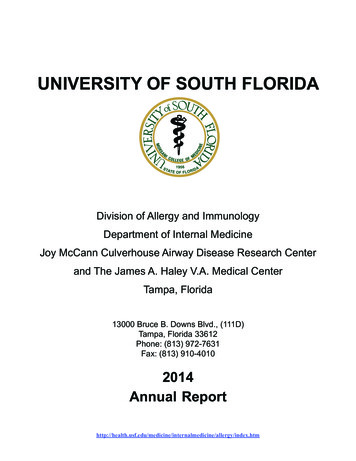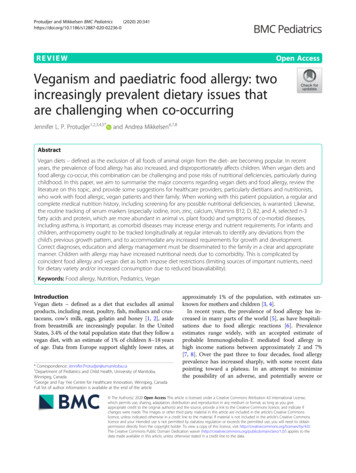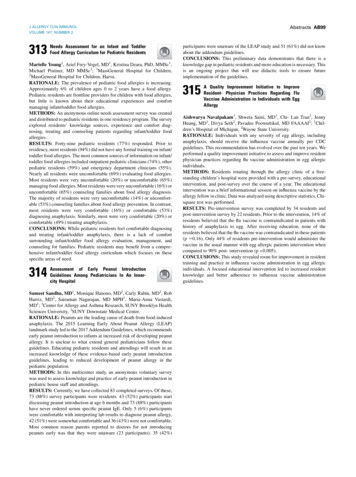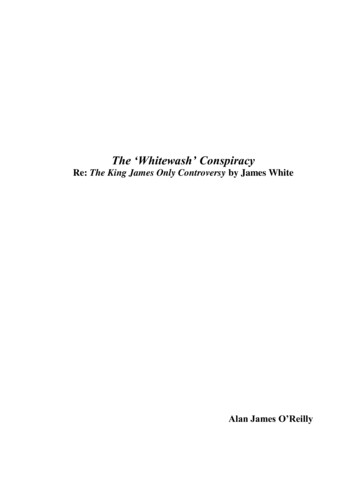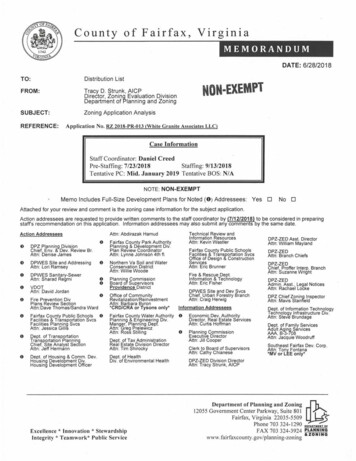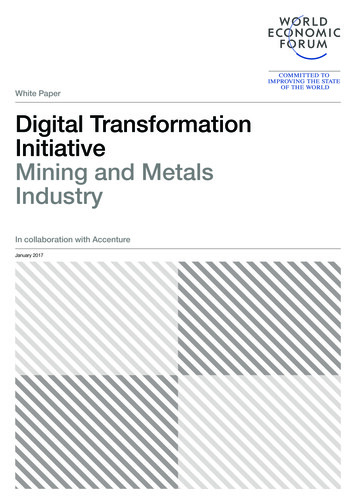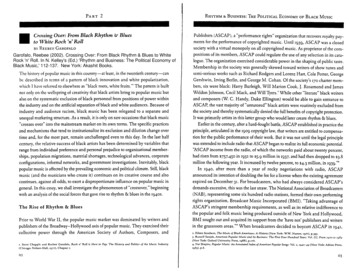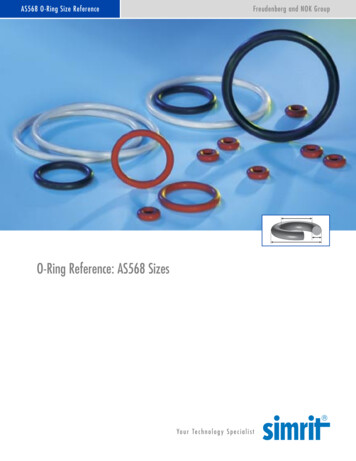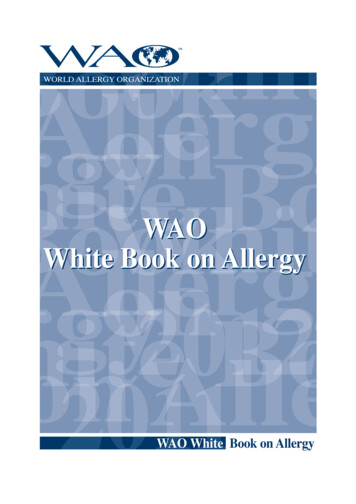
Transcription
WORLD ALLERGY ORGANIZATIONWAOWhite Book on AllergyWAO White Book on Allergy
World Allergy Organization (WAO)White Book on AllergyCopyright 2011 World Allergy Organization
WAO White Book on AllergyEditorsProf. Ruby Pawankar, MD, PhDWAO President Elect (2010-2011)Allergy and RhinologyNippon Medical School1-1-5 Sendagi, Bunkyo-kuTokyo 113-8603JAPANProf. S tephen T. Holgate, BSc, MD,DSc, FMed SciMember, WAO Board of Directors (2010-2011)Medical Research Council Clinical Professor ofImmunopharmacologyInfection, Inflammation and ImmunitySchool of MedicineUniversity of SouthamptonLevel F, South BlockSouthampton General HospitalTremona RoadSouthampton SO16 6YDUnited KingdomProf. Giorgio Walter Canonica, MDWAO Past President (2010-2011)Allergy & Respiratory DiseasesDepartment of Internal MedicineUniversity of GenoaPadiglione Maragliano, Largo Rosanna Benzi 101-16132 GenoaITALYProf. Richard F. Lockey, MDWAO President (2010-2011)Division of Allergy & ImmunologyJoy McCann Culverhouse Chair in Allergy & ImmunologyUniversity of South Florida College of MedicineJames Haley Veterans Administration Medical Center (111D)13000 Bruce B. Downs BoulevardTampa, Florida 33612USAAcknowledgementOn behalf of the World Allergy Organization (WAO), the editors and authors of the WAO White Book on Allergy express theirgratitude to the charity, Asthma, Allergy, Inflammation Research (AAIR) and Asian Allergy Asthma Foundation (AAAF) for theirsupport in the production of this publication.The Editors of the White book extend their gratitude to His Excellency Dr. APJ Abdul Kalam, Former President of India andMadame Ilora Finlay Baronness of the House of Lords for their Forewords to the White Book and to the International PrimaryCare Respiratory Group (IPCRG) and European Federation of Allergy and Airways Diseases Patients ‘Associations (EFA) for theirsupporting statements.The editors also wish to thank the many experts around the world who have contributed to the completion of this book. Boththe editors and authors also thank WAO staff members, Charu Malik and Karen Henley, for their editorial assistance, and SofiaDorsano, for her technical assistance, in preparing the White Book.ISBN-10 0615461824ISBN-13 9780615461823Copyright 2011 World Allergy Organization (WAO). All rights reserved.No part of this publication may be reproduced in any form without the written consent of the World Allergy Organization.This book is not for sale.World Allergy Organization555 East Wells StreetSuite 1100Milwaukee, Wisconsin 53202United States of AmericaPhone: 1 414 276 1791Fax: 1 414 276 3349Email: info@worldallergy.orgWebsite : www.worldallergy.orgPrinted in the United Kingdom, 2011
World Allergy Organization (WAO)White Book on AllergyEditorsRuby PawankarGiorgio Walter CanonicaStephen T. HolgateRichard F. LockeyCopyright 2011 World Allergy Organization
WAO White Book on AllergyForeword by His ExcellencyDr. APJ Abdul Kalam,Former President of IndiaAllergic diseases are increasing worldwide with unprecedentedThe White Book on Allergy is an important initiative by thecomplexity and severity. Children bear the greatest burden ofWorld Allergy Organization calling on international and nationalallergic deseases.The most common allergic conditions inhealth care policy makers to address early identification ofchildren are food allergies, eczema, and asthma. The precisesymptoms, early diagnosis and appropriate strategies tocauses of this increase in allergic diseases are not fully understoodmanage and control allergies to avoid worsening of severebut as the numbers of afflicted people increase, so does theallergic disease to people at risk and to improve practice inresearch and development, and progress is being made.this clinical field of medicine for the benefit of those sufferingAllergy should be recognized as a public health problem andefforts should be made towards its prevention and optimaltreatment.To achieve this, public awareness should beincreased and efforts should be made towards proper educationfrom the consequences of allergies. I congratulate the WorldAllergy Organization for initiating this timely and much neededdocument and wish them all success in its impact andimplementation.and training for more integrated and holistic approach to thediagnosis and management of allergic diseases.HE. Dr. APJ Abdul KalamFormer, President of IndiaNew Delhi, IndiaCopyright 2011 World Allergy Organization1
WAO White Book on AllergyForeword by Baroness Finlay,House of Lords, United KingdomI am delighted to have an opportunity of adding my strongestto provide education and training courses for allergy patients;support to the principles laid out in this World Allergy Organizationtheir families; school staff and employers; in how to prevent andWhite Book on Allergy. Indeed, many of the recommendationstreat allergic conditions.align with those of a recent report on Allergy Services that I wasasked to chair in 2006 for the UK House of Lords Committeeon Science Technology /ldselect/ldsctech/166/166i.pdf). The scopeof the Report encompassed an assessment of recent trendsof allergy prevalence, the social and economic burdens thatallergic disorders cause, current allergy treatments and2) Because of the lack of knowledge of health professionalsin the diagnosis and treatment of allergic diseases, werecommended that those responsible for medical trainingstrengthen the input of clinical allergy to the undergraduateand postgraduate training of internists and primary carephysicians as well of those of nurses.research strategies, and policies which impact upon allergy3) Although high quality research into cellular and molecularpatients such as housing standards, food labelling and themechanisms of allergy is advancing, the factors contributingwork and school environments. As with the White Book, ourto allergy development and the “allergy epidemic,” are poorlyreport came at a time when the prevalence of allergic disordersunderstood. It is imperative that further research shouldin this country has been claimed to have reached epidemicfocus on the environmental factors, such as early allergenproportions. Although it is unlikely that a cure for all forms ofexposure, which may contribute to the inception, preventionallergy will be found in the near future, we have made a numberor exacerbation of allergic disorders. We were concernedof recommendations which we believe will contribute to thethat the knowledge gained from cellular and molecularprevention, treatment and management of allergic disorders.research in allergy was not being translated into clinicalOur main conclusions and recommendations were:practice and was identified as an area of unmet need that1) There is a need for Allergy centres where specialist, highrequired greater priority.quality diagnostic and treatment services that are accessibleImmunotherapy is a valuable resource in the prophylacticto the public. Once a diagnosis is obtained and a treatmenttreatment of patients with life-threatening allergies, or whoseplan developed at the allergy centre, the patient’s diseaseallergic disease does not respond to other medication.can often be managed back in primary or general secondaryAlthough initially expensive, immunotherapy can preventcare. However, patients with severe or complex allergica symptomatic allergic response for many years, and mayconditions may need long-term follow-up from specialists inprevent the development of additional allergic conditions, sothe allergy centre.its wider use could potentially result in significant long-termAllergen immunotherapy by injection should always be carriedout by specialists within the allergy centre because of the riskof anaphylaxis. Collaboration between clinicians in primary,secondary and tertiary care is key to improving the diagnosissavings for health services. Full cost-benefit analyses of thepotential health, social and economic value of immunotherapytreatment needs to be conducted so the case for its use andfunding can be strengthened.and management of people with allergic conditions. Once4) We recognised the appreciable impact that allergic rhinitisestablished, the allergy centre in each geographical regionhas on student performance in schools and examinations.should encourage and co-ordinate the training of local GPsIndeed, we wished to encourage health professionals toand other healthcare workers in allergy. In a “hub and spokes”interface more closely with schools to ensure children withmodel, the allergy centre, or “hub,” would act as a centralallergic disease receive optimal care. We support the usepoint of expertise with outreach clinical services, educationof individual care plans for children with medical needs.and training provided to doctors and nurses in primary andHowever, we were concerned that many teachers andsecondary care, the “spokes.” In this way, knowledge regardingsupport staff within schools are not appropriately educated inthe diagnosis and management of allergic conditions would behow to deal with allergic emergencies and should take urgentdisseminated throughout the region.remedial action to improve this training where required. WeThe allergy centre should also act as a lead in providing publicinformation and advice. Specialists at the centre should work incollaboration with allergy charities, schools and local businesseswere especially concerned about the lack of clear guidanceregarding the use of autoinjectors of adrenaline on childrenwith anaphylactic shock in the school environment.Copyright 2011 World Allergy Organization3
4Pawankar, Canonica, Holgate and Lockey5) We considered that controlled trials should be conducted9) We were also concerned that the results of allergy self-testinginvolving multiple interventions to examine the effect ofkits available to the public are being interpreted without theventilation, humidity and mite-reduction strategies onadvice of appropriately trained healthcare personnel, and thatallergy development and control. As climate change and airthe IgG food antibody test is being used to diagnose foodpollution may significantly impact upon the development ofintolerance in the absence of stringent scientific evidence.allergic disease, we supported greater effort to take accountWe recommend that further research into the relevance ofof the interlinkages between air quality, climate change andIgG antibodies in food intolerance together with and thehuman health.necessary controlled clinical trials should be conducted.6) Vague defensive warnings on food product labels forAlthough my task was to direct our activity to issues relevantconsumers with food allergy can lead to dangerous confusionto allergy as occurs in the United Kingdom, nevertheless, it isand an unnecessary restriction of choice. We recommendremarkable how closely our recommendations from the Housethat the responsible government agencies should ensureof Lords Report that I chaired resonate with those of the Allergythe needs of food-allergic consumers are clearly recognisedWhite Book. Following the presentation of our Report to the UKduring any review of food labelling legislation. Many teenagersGovernment, I was asked to establish an Implementation Groupand young adults with food allergies sometimes takeby the Royal Colleges of Physicians and Pathologists (http://dangerously high risks when buying food. We consideredbookshop.rcplondon.ac.uk/details.aspx?e 317). I would likethat the relevant government agencies, charities and otherto suggest that following the launch of the Allergy White Bookstakeholders should explore novel ways to educate youngby the WAO, implementation groups are established in eachpeople about allergy and the prevention of anaphylaxis.country and by the WAO as a whole to monitor uptake of theAs sensitivities to various allergens vary widely, the settingof standardised threshold levels for package labelling isrecommendations and their impact, to improve practice for thebenefit of patients with allergy.potentially dangerous for consumers with allergies. Instead, weI wish to use this opportunity to congratulate the WAO forconsidered that food labels should clearly specify the amountinitiating this timely Report, all those who have contributed toof each allergen, and if it is contained within the products, weits content and especially those in different countries whosewish to discourage vague defensive warnings. The phrasesallergy societies have contributed their own experiences. I wish“hypoallergenic” and “dermatologically tested” are almostyou every success in its impact and uptake.meaningless, as they only demonstrate a low potential for theBaroness Ilora FinlayHouse of LordsWestminsterLondon, UKproducts to be a topical irritant. Such products should warnthose with a tendency to allergy that they may still get a markedreaction to such products.8) In various parts of the world, traditional and complementarymedical interventions for treating allergic disease areavailable and frequently accessed by the public, but theevidence base for this is poor. We recommend that robustresearch into the use of complementary diagnostic tests andtreatments for allergy should examine the holistic needs ofthe patient, assessing not only the clinical improvement ofallergy symptoms, but also analysing the impact of thesemethods upon patient well-being. Such trials should haveclear hypotheses, validated outcome measures, and riskbenefit and cost-effectiveness comparisons made withconventional treatments.Copyright 2011 World Allergy Organization
WAO White Book on AllergySupporting Statement by theInternational Primary CareRespiratory GroupAuthorsDermot Ryan: General Practitioner, Woodbrook MedicalCenter, Loughborough, LE11 1NH, UK.Osman Yusuf: Director (Research) IPCRG; Chief Consultant,The Allergy & Asthma Institute, Pakistan.Marianne Stubbe Ostergaard: Associate Professor of.General Practice, University of Copenhagen, Blegdamsvej 3;DK-2200 N, Copenhagen, DenmarkMiguel Román-Rodríguez: President IPCRG: Son PisaPrimary Care Centre. IB-Salut Family Medicine Training Unit,Mallorca, Baleares, SpainAbout the InternationalPrimary Care RespiratoryGroup (www.theipcrg.org)The IPCRG provides a forum for its constituent national groupsencompassing different health systems models and socioeconomic status ranging from those that have a completehealth care system to those where the state plays little partin the provision of health care. It represents internationalprimary care perspectives in respiratory medicine trying to raisestandards of care in individual countries and globally, throughThe primary care perspectiveon respiratory allergiesIntroductionAlthough there are differences among countries, theincidence and prevalence of asthma and rhinitis isincreasing worldwide. These differences in some countriescould be due to underreporting or a lack of awarenessof these diseases in deference to more important socioeconomic medical problems. However, in general,patients with asthma are inadequately managed andasthma and rhinitis are both under-recognized1 for theirimpact on the health and decreased quality of life of thoseafflicted. In addition, studies to assess prevalence andcare delivery show that there is a large variation amongcountries in the delivery of care to those suffering fromasthma and allergy2. What is common among severalcountries, however, is that the majority of patients whoseek medical advice for allergy and asthma are seeninitially in primary care3 because there are inadequatenumbers of trained allergists to meet the needs of somany patients4.collaborative research, innovation and dissemination of bestThe most common reasons for presentation to primary carepractice and education. It co-publishes with the UK Primaryare respiratory symptoms, encompassing both acute infectionsCare Respiratory Society (PCRS) the Primary Care Respiratoryand long-term conditions such as asthma, rhinitis, and chronicJournal http://www.thepcrj.org/, a free online, Medline listedobstructive pulmonary disease (COPD). Asthma and asthmajournal.attacks are often triggered by allergies. It is, therefore, importantThe IPCRG is an associate member of WAO with whichorganization it has many areas of overlap given the allergicetiology of many common respiratory disorders.that primary care physicians also assess the allergic triggers ofthese diseases. However, proper diagnosis and treatment forallergy and asthma are limited by the inadequate state of allergyknowledge within primary care. (The WAO estimate of allergyprevalence of the whole population by country ranges between10 - 40%).III Allergy training at the undergraduate level is almostnon-existent in several countries, paired with little exposure topost-graduate allergy training except for physicians pursuing acareer in allergy. It is not surprising that allergists obtain superioroutcomes with asthma sufferers compared to the primary carephysicians who see the majority of the patients.Copyright 2011 World Allergy Organization5
6Pawankar, Canonica, Holgate and LockeyUnmet Needs 2. GPs with a special interest: A further possibility is toManagement of Allergy: The limited data availablecreate a cohort of General Practitioners with a specialsuggest that a structured approach to care delivery hasinterest in allergy with the joint task of developing anda positive impact on outcomes, and at reduced costs. Aproviding a clinical service in primary care at the samesystematic approach to disease management has beentime as raising skills within their community9. To date thereundertaken in Finland in the area of asthma which hasis only one recorded incidence of this innovative proposaldelivered decreased morbidity, mortality and, of particularhaving reached fruition, but it was a success.10interest to governments worldwide, decreased costs,3. Guidelines in Allergy: Regularly produced and updatedboth direct and indirect. This program is being furtherinternational and national allergic respiratory diseasesdeveloped to reduce the impact of allergic disease.5 Theguidelines will help to promote high quality care in primaryUnited Kingdom Royal College of Physicians publishedcare, Primary Care physicians need to be appropriatelya document, “Allergy the Unmet Need” in 20036 whichrepresented on these guideline committees to ensure thatprovides descriptions of prevalence of allergic diseasethey are grounded in what is realistic and achievable.as well as current service delivery and training needspertaining to allergy care. This study may be used as aReferences1. auchau V, Durham SR. Prevalence and rate of diagnosis of allergicBrhinitis in Europe. Eur Respir J. 2004 Nov;24(5):758-64.2. abe KF, Adachi M, Lai CK, Soriano JB, Vermeire PA, Weiss KB, WeissRST Worldwide severity and control of asthma in children and adults:the global asthma insights and reality surveys. J Allergy Clin Immunol.2004 Jul;114(1):40-73.Ryan D, van Weel C, Bousquet J, Toskala E, Ahlstedt S, Palkonen S,van den Nieuwenhof L, Zuberbier T, Wickman M, Fokkens W. Primarycare: the cornerstone of diagnosis of allergic rhinitis. Allergy. 2008Aug;63(8):981-9.4. nrico Compalati, Martin Penagos, Henley Karen, G. Walter Canonica.EPrevalence Survey by the World Allergy Organization. Allergy ClinImmunol Int: J World Allergy Org, vol. 19, no. 3, pp. 82-905.Haahtela T, von Hertzen L, Mäkelä M, Hannuksela M; AllergyProgramme Working Group. Finnish Allergy Programme 2008-2018-time to act and change the course. Allergy. 2008 Jun;63(6):634-45.document detailing the needs for developed and LMIC.76.‘Allergy: The Unmet Need’ – a blueprint for better patient care’ RoyalCollege of Physicians 2003.Awareness of allergic problems: Governments globally7. innock H, Thomas M, Tsiligianni I et al. The International Primary CarePResearch Group Research Needs Statement 2010. PCRJ June 2010,19, Supple 1, pp 1-20)8.Potter PC, Warner JO, Pawankar RS, Kaliner MA, Del GiaccoA, Rosenwasser L, for the WAO Specialty and Training Council.Recommendations for Competency in Allergy Training forUndergraduates Qualifying as Medical Practitioners: A WorldAllergy Organization Position Paper. World Allergy Organization J.2009;2(8):150-189).9.Ryan D, Levy M, Morris A, Sheikh A, Walker S. Management of allergicproblems in primary care: time for a rethink? Prim Care Respir J. 2005Aug;14(4):195-203. Epub 2005 Jul 11)model of assessment by countries wishing to adopt astructured approach to care delivery or similar solutionsfor optimal patient care. These solutions, of course, needto be country-specific and will depend on national healthcare delivery systems. Research in Allergy: Extensive research is needed at thePrimary Care level for the diagnosis, prevention, treatmentand management of all types of respiratory and relatedallergies in both developed and developing / low andmiddle income countries (LMIC). The International PrimaryCare Respiratory Group (www.theipcrg.org) focuses onsuch research needs, and has produced a comprehensive need to be made aware of the morbidity currently causedby respiratory and allergic disorders and associated costs.Some of these costs may as yet be poorly quantified,particularly the costs of presenteeism (when someoneis present at work but with reduced productivity due toa disease or the treatment for that disease), as well asabsenteeism. With the proper awareness of the scopeof the problem, governments need to ensure that thetraining, skills and infrastructure exist with which todevelop and provide effective and efficient care delivery.10. Levy ML, Walker S, Woods A, Sheikh A. Service evaluation of a UKprimary care-based allergy clinic: quality improvement report. PrimCare Resp J. 2009;18:313–319.1. Training in Allergy: The WAO has led the way indescribing the minimum allergy curriculum requirements atthe undergraduate level8. Introducing a structured allergycurriculum into undergraduate training may, of course,take several years to make a significant impact. However,given that allergy is so prevalent, allergy training in someform, even modular, should be considered an essentialpart of general professional training for all physicians.Copyright 2011 World Allergy Organization
WAO White Book on AllergySupporting Statement by EFAfor WAO White Book on AllergyEFA identifies low public awareness of allergies as seriouschronic diseases as major issue. Therefore EFA developeda four-year awareness program calling on the media toreport the alarming facts of allergies with the aim to raiseawareness of respiratory, skin and food allergies as well asanaphylaxis as serious chronic diseases. EFA is also callingon international and national health care policy makers toaddress early identification of symptoms, early diagnosis andThe European Federation of Allergy and AirwaysDiseases Patients’ Associations (EFA) congratulates theWorld Allergy Organization (WAO) for leading the effortin developing this first global WHITE BOOK on Allergy,since it brings the discussion about allergy back inEurope to the public mind and highlights the negativeimpact on the quality of life of people with allergies andthe huge burden on national economic systems!appropriate strategies to manage and control allergies to avoidexacerbations of severe allergies to people at risk, primary carephysicians, paediatricians, and pharmacists.With these activities EFA wants to support the outstandingwork of WAO and wishes the WAO WHITE BOOK as muchresonance as possible as it will be important to achieve ouraims as well.While allergy does not enjoy the same level of public andgovernmental attention as other chronic diseases like canceror cardiovascular diseases, it is certainly the most pervasivedisorder globally. Allergic conditions pose a major public healthproblem, as it is documented in this WAO WHITE BOOK andpublications of other leading bodies. They respect no nationalMarianella Salapatas,EFA Presidentfrontiers. One major risk is that allergic diseases often are notperceived as serious chronic diseases and therefore are notdiagnosed early enough and not treated consequently. Dueto this underestimation the global community often ignoresallergy and does not act appropriately, even if the increase inglobal prevalence is such that between 20-30% of the world spopulation suffers from some form of allergic disease.Antje-H. Fink-Wagner,EFA Project & Fundraising OfficerIn Europe, one in four children is allergic and it is documentedthat 87 million people suffer from allergies. 40% of patients withallergic rhinitis have asthma and up to 80-90% of asthmaticshave also allergic rhinitis. This one airway concept needs to bebetter understood by the lay public since allergic rhinitis andasthma greatly impact the daily life of patients and their families,as well as their performance at school, work or social activities.Taking into consideration the rising prevalence of allergies,EFA decided in 2009 to go global. EFA built the Global Allergyand Asthma Patient Platform (GAAPP). During the WorldAllergy Congress 2009 ( the official congress of WAO) GAAPPannounced the “Declaration of Buenos Aires” on the rights andresponsibilities of people with allergies, signed and supportedby patient organisations and patient supporters around theworld.Copyright 2011 World Allergy Organization7
8Pawankar, Canonica, Holgate and LockeyCopyright 2011 World Allergy Organization
WAO White Book on AllergyTable of ContentsIntroduction and Executive Summary11Establishing the need to treat Allergic Diseases as a Global Public Health issueRuby Pawankar, Giorgio Walter Canonica, Stephen T. Holgate, Richard F. LockeyWAO Declaration of Recommendations21How to Address Allergic Diseases as a Global Public Health IssueRuby Pawankar, Giorgio Walter Canonica, Stephen T. Holgate, Richard F. LockeyChapter 1. The Practice of Allergology23Authors: Michael A Kaliner, Sergio Del GiaccoChapter 2. The Burden of Allergic Diseases272.127Rhinitis, Conjunctivitis, and RhinosinusitisRuby Pawankar, Mario Sanchez-Borges, Sergio Bonini, Michael A. Kaliner2.234Asthma Stephen T. Holgate, Giorgio Walter Canonica, Carlos E. Baena-Cagnani,Thomas Casale, Myron Zitt, Harold Nelson, Pakit Vichyanond2.3Atopic Eczema and Contact Dermatitis39Thomas Bieber, Donald Leung, Juan-Carlos Ivancevich, Yehia El Gamal2.443AnaphylaxisRichard F Lockey, Stephen Kemp, F.Estelle R Simons, Philip Lieberman, Aziz Sheikh2.547Food AllergyAlessandro Fiocchi, Hugh A. Sampson, Sami L. Bahna, Gideon Lack2.653Urticaria and AngioedemaTorsten Zuberbier, Carsten Bindslev Jensen, Allen P. Kaplan2.757Allergy to Drugs and BiologicsMarek L. Kowalski, Pascal Demoly, Werner Pichler, Mario Sanchez- Borges2.862Insect allergyMarek Jutel, Takeshi Fukuda, Anthony Frew, Patrizia Bonadonna, Richard F Lockey2.965Occupational AllergyOlivier Vandenplas, Margitta Worm, Paul Cullinan, Hae-Sim Park, Roy Gerth van Wijk702.10 Sports and AllergiesSergio Bonini, Kai-Håkon Carlsen, Sergio Del Giacco, William W StormsChapter 3. Risk Factors for Allergic Disease753.175Genetic aspectsJohn Holloway, Ian Yang, Lanny J. Rosenwasser, Stephen T. Holgate3.279AllergensThomas A. E. Platts-Mills, Bee Wah Lee, Karla Arruda, Fook Tim Chew3.3Environmental risk factors: indoor and outdoor pollutionSara Maio, Sonia Cerrai, Marzia Simoni, Giuseppe Sarno, Sandra Baldacci, Giovanni ViegiCopyright 2011 World Allergy Organization849
10Pawankar, Canonica, Holgate and Lockey3.4Socio-economic factors and environmental injustice91Rosalind J Wright, Michelle J Sternthal3.595Climate Change and MigrationGennaro D’Amato, Menachem RottemChapter 4. Evidence Based Approachesto Diagnosis and Management4.1Diagnosis and identification of causative allergens101101Mario Sanchez Borges, Juan-Carlos Ivancevich, Noel Rodriguez Perez, Ignacio Ansotegui4.2106PharmacologicalCarlos E Baena-Cagnani, Héctor Badellino4.3110ImmunotherapyGiovanni Passalacqua, Dennis K. Ledford, Linda Cox, Paul Potter, Giorgio Walter Canonica4.4116BiologicalsVesselin Dimov, Jeffrey R Stokes, Thomas B Casale, Stephen T. Holgate4.5123Patient EducationJohn O.Warner, Erkka Valovirta4.6127Allergen AvoidanceAdnan Custovic, Roy Gerth Van WijkChapter 5. Prevention of Allergic Diseases133Tari Haahtela, Leena Von Hertzen, Adnan CustovicChapter 6. Health Care, Health Economicsand Medical Education in Allergy6.1139139Health Care, Health EconomicsJay Portnoy, Martyn Partridge6.2142Medical Education in AllergyPaul Potter, John O Warner, Ruby Pawankar, Jill A.Warner, Paul Van Cauwenberge, Michael A. Kaliner6.3Cost Effectiveness of consulting an allergist147Jose Gereda, Paul Potter, Sergio Del Giacco, Michael A KalinerMember Society Survey Report153Author Affiliations209Copyright 2011 World Allergy Organization
WAO White Book on Allergy11Allergic Diseases as a GlobalPublic Health Issuetheir ailments. In some countries, patients are repeatedly toldR. Pawankar, GW Canonica, ST.Holgate, RF Lockeyunderstand the prevalence and significance of allergic diseasesthat priorities for diagnosis and treatment of allergic diseaseare determined at the local governmental level, i.e., by “PrimaryCare Trusts”. However, if representatives at this local level do notIntroductionand ExecutiveSummaryIntroduction and Executive Summaryand their complications, what hope is there for them to chooseThe prevalence of allergic diseases worldwide is risingdramatically in both developed and developing countries.These diseases include asthma; rhinitis; anaphylaxis;drug, food, and insect allergy; eczema; and urticaria (hives)and angioedema. This increase is especially problematicin children, who are bearing the greatest burden of therising trend which has occurred over the last two decades.In spite of this increase, even in the developedworld, services for patients with allergic diseases arefragmented and far from ideal. Very few countries havecomprehensive services in this field of medicine.impor
As with the White Book, our report came at a time when the prevalence of allergic disorders in this country has been claimed to have reached epidemic proportions. Although it is unlikely that a cure for all forms of allerg
